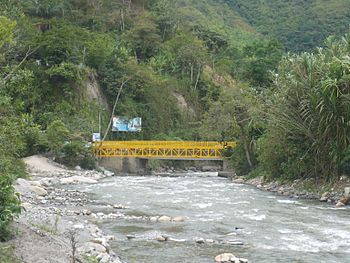Coello River facts for kids
Quick facts for kids Coello River |
|
|---|---|

Coello River in Coello-Cocora
|
|
| Country | Colombia |
| Physical characteristics | |
| Main source | Nevado del Tolima 3,600 m (11,800 ft) |
| River mouth | Magdalena River 256 m (840 ft) |
| Length | 111.6 km (69.3 mi) |
| Basin features | |
| Basin size | 1,899 km2 (733 sq mi) |
The Coello River is an important river located in the Tolima Department of Colombia. It plays a key role in the local environment. This river flows into the much larger Magdalena River. Eventually, its waters travel all the way to the Caribbean Sea.
Contents
Where Does the Coello River Start?
The Coello River begins high up in the mountains. Its source is found on the slopes of the Nevado del Tolima. This is a large, snow-capped volcano in Colombia. The river starts at an elevation of about 3,600 meters (11,811 feet). Imagine water flowing down from such a high place!
The Journey of the Coello River
The Coello River travels a distance of about 111.6 kilometers (69.3 miles). As it flows, it collects water from a large area. This area is called its basin. The Coello River basin covers about 1,899 square kilometers (733 square miles). This means a lot of land drains into this river.
Joining the Magdalena River
The Coello River eventually meets the Magdalena River. This happens at an elevation of about 256 meters (840 feet). The Magdalena River is one of Colombia's longest and most important rivers. When the Coello joins it, its waters become part of a much bigger journey.
Flowing to the Caribbean Sea
After joining the Magdalena River, the waters of the Coello River continue their path north. They travel through Colombia. Finally, they reach the vast Caribbean Sea. This shows how all rivers are connected. They form a huge network that carries water across the land.
Why Rivers Are Important
Rivers like the Coello River are vital for many reasons.
- They provide fresh water for plants, animals, and people.
- They support different types of ecosystems.
- Rivers can be used for transportation.
- They help shape the landscape over time.
See also
 In Spanish: Río Coello para niños
In Spanish: Río Coello para niños

